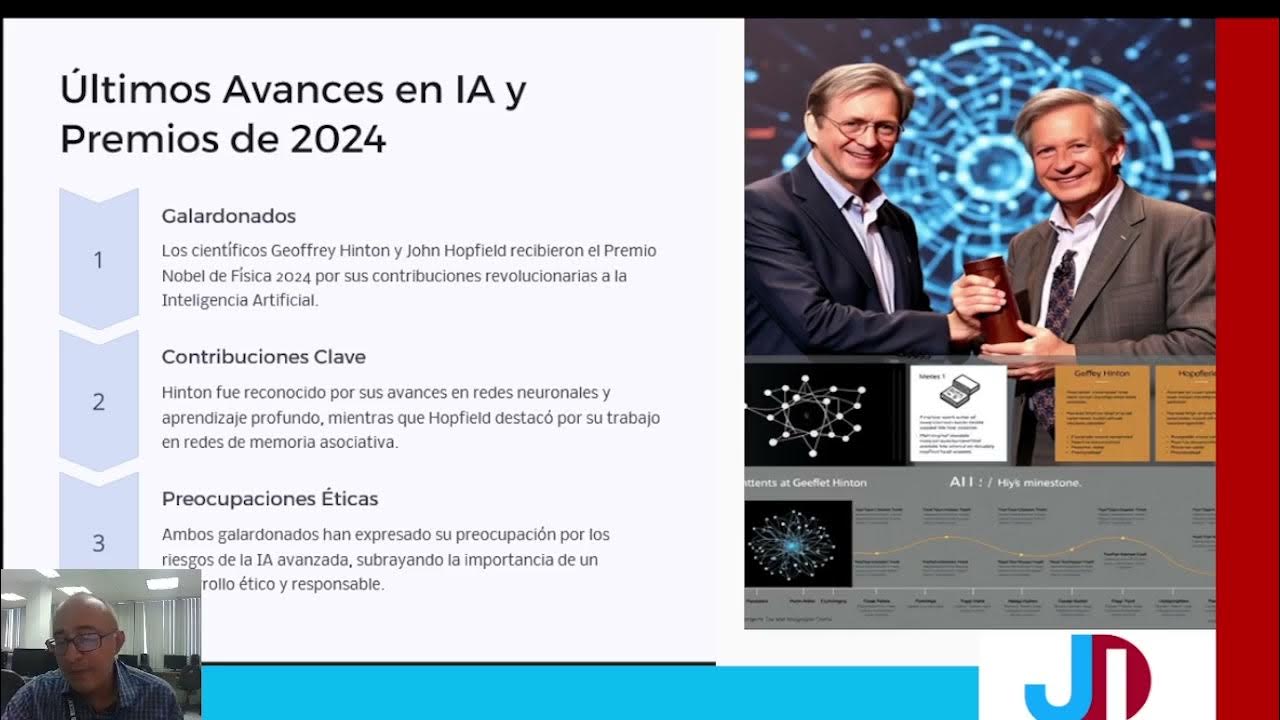Yann Lecun | Objective-Driven AI: Towards AI systems that can learn, remember, reason, and plan
Summary
TLDRYann LeCun在哈佛的演讲中探讨了人工智能的未来,特别是目标驱动的AI系统。他强调了当前AI系统与人类和动物相比在学习和理解世界方面的局限性,并提出了一种新的AI架构理念,包括自我监督学习和能量模型。LeCun认为,开源AI平台对于民主和技术创新至关重要,同时对未来的智能助理和增强人类全球智能表示乐观。
Takeaways
- 🌟 人工智能(AI)的未来不应仅仅是基于现有的大型语言模型(LLMs),而应发展为具有目标驱动的AI架构。
- 🚀 目前的AI系统与人类和动物相比在学习和理解世界方面存在显著不足,例如缺乏常识和目标驱动的行为。
- 📈 自监督学习在AI领域的成功,特别是在文本、图像识别和语音翻译等方面,为未来的AI发展提供了新的可能性。
- 🧠 人类和动物能够快速学习新任务并理解世界运作的原理,而现有的AI系统还远未达到这种能力。
- 🔍 为了实现更智能的AI系统,我们需要构建能够从感官输入中学习世界模型、具有持久记忆和能够进行层次化规划的系统。
- 🛠️ 我们目前的AI系统在逻辑理解、常识推理和现实世界知识方面存在局限,这些都需要通过新的学习范式来克服。
- 🔗 未来的AI系统将与我们的数字世界互动,因此需要具备与人类智能相当的水平,以提供更好的用户体验和服务。
- 🌐 开源AI平台对于实现AI技术的多样性和普及至关重要,有助于防止AI技术被少数公司垄断。
- 📚 教育和研究机构需要深入研究能量模型和基于能量的学习,以发展更高效和安全的AI系统。
- 📈 通过自监督学习和联合嵌入架构(JEPA),AI系统可以在不依赖大量标记数据的情况下学习有效的特征表示。
- 🔑 为了确保AI系统的安全性和可控性,需要在其架构中嵌入保护性目标(Guardrail objectives)和安全控制机制。
Q & A
Yann LeCun 在演讲中提到了哪些关于机器学习未来发展的主要观点?
-Yann LeCun 主要讨论了机器学习未来的发展,特别是关于目标驱动的人工智能(Objective-Driven AI)。他强调了当前AI系统相比于人类和动物的学习效率和理解世界的能力还有很大的差距。他提出了建立与人类智能水平相当的系统的必要性,并探讨了实现这一目标的挑战和可能的途径,包括自我监督学习、能量模型和预测架构等。
Yann LeCun 认为现有的AI系统在学习效率和理解世界方面存在哪些不足?
-Yann LeCun 认为现有的AI系统相较于人类和动物在学习效率上有显著不足。例如,人类和动物能够快速地通过少量样本或尝试来运行新任务,而AI系统则需要更多的数据和计算资源。此外,人类和动物能够理解世界如何运作,具有推理和规划的能力,以及常识,而这些都是当前AI系统所缺乏的。
Yann LeCun 提出的Objective-Driven AI架构包含哪些关键组成部分?
-Objective-Driven AI架构的关键组成部分包括感知模块、可能的持久记忆、世界模型、执行器、成本模块和目标函数。这种架构的目标是通过优化目标函数来规划一系列行动,从而实现预测的结果满足特定的目标。
Yann LeCun 为什么认为自我监督学习对于AI的发展至关重要?
-Yann LeCun 认为自我监督学习是AI发展的关键,因为它是最近AI领域取得重大进展的主要原因。自我监督学习通过从数据中提取内在结构来训练模型,而不需要显式的标注。这种方法使得模型能够更好地理解和处理数据,从而在多种任务中表现出色,如语言模型、图像识别和语音识别等。
Yann LeCun 如何看待当前的强化学习?
-Yann LeCun 认为当前的强化学习虽然给人带来了希望,但实际上效率很低,在现实世界中几乎是不切实际的,除非更多地依赖于自我监督学习。他提出需要新的学习范式,即目标驱动的AI架构,以实现更智能、更安全的AI系统。
Yann LeCun 提出了哪些关于未来AI系统的预测和建议?
-Yann LeCun 预测未来的AI系统将会与我们的日常数字交互紧密相关,并且我们需要建立具有人类水平智能的系统。他建议我们需要开放源代码的AI平台,以便任何人都可以根据自己的语言、文化和价值观来微调AI系统。他还强调了在发展AI的同时,要确保其安全性和可控性,避免潜在的风险。
Yann LeCun 如何看待当前的生成式AI模型?
-Yann LeCun 认为生成式AI模型在处理文本方面效果不错,但对于图像和其他高维连续数据则不够有效。他提出应该放弃生成式模型,转而使用联合嵌入预测架构(JEPA),因为这些架构能够提供更好的内部表示,并且对于预测和规划等任务更为有效。
Yann LeCun 为什么认为能量模型比概率模型更适合当前的AI学习?
-Yann LeCun 认为能量模型提供了一种更直接的方式来处理数据的兼容性或不兼容性,而不需要担心概率模型中的归一化问题。能量模型允许我们通过直接操作能量函数来避免处理分母(分区函数),这在许多统计物理问题中是难以处理的。此外,能量模型在理论上更为灵活,可以更容易地实现正则化,从而避免模型崩溃。
Yann LeCun 如何看待当前的深度学习模型在逻辑理解方面的能力?
-Yann LeCun 认为当前的深度学习模型,尤其是大型语言模型,虽然在文本生成方面表现出色,但它们并不真正理解逻辑。这些模型可能需要显式地教授如何执行算术运算,并且它们缺乏对现实世界的基本理解。因此,尽管它们能够流畅地生成文本,但并不意味着它们具有高级的智能或理解能力。
Yann LeCun 讨论了哪种自我监督学习方法,并认为它在图像识别方面的效果如何?
-Yann LeCun 讨论了一种名为MAE(Masked Auto-Encoder)的自我监督学习方法,这种方法通过遮蔽图像的一部分并训练模型来重建缺失的部分。他认为,尽管这种方法在重建图像方面取得了一定的成功,但它在生成内部表示方面并不如联合嵌入方法有效。
Yann LeCun 对于未来AI系统的安全性和可控性有哪些建议?
-Yann LeCun 建议通过建立目标驱动的AI架构来确保系统的安全性和可控性。这包括使用世界模型来预测行动的后果,以及通过优化目标函数来规划行动序列。此外,他还提出了使用guardrail目标来确保系统的安全可控。
Yann LeCun 如何看待当前AI系统在处理非语言知识方面的能力?
-Yann LeCun 认为当前的AI系统主要依赖于文本数据,而大多数人类知识实际上是非语言的。他指出,我们通过观察世界获得的背景知识远远超过了公开可用的文本数据。因此,仅通过语言训练的AI系统无法达到人类水平的智能。
Outlines

This section is available to paid users only. Please upgrade to access this part.
Upgrade NowMindmap

This section is available to paid users only. Please upgrade to access this part.
Upgrade NowKeywords

This section is available to paid users only. Please upgrade to access this part.
Upgrade NowHighlights

This section is available to paid users only. Please upgrade to access this part.
Upgrade NowTranscripts

This section is available to paid users only. Please upgrade to access this part.
Upgrade NowBrowse More Related Video

Yann LeCun: Deep Learning, ConvNets, and Self-Supervised Learning | Lex Fridman Podcast #36

Ilya Sutskever: OpenAI Meta-Learning and Self-Play | MIT Artificial General Intelligence (AGI)

Security in the Age of Agentic AI

What we see and what we value: AI with a human perspective—Fei-Fei Li (Stanford University)

Season 2 Ep 22 Geoff Hinton on revolutionizing artificial intelligence... again

Inteligencia Artificial General (AGI) Y Supe inteligencia Artificial (ASI):Perspectivas y desafíos
5.0 / 5 (0 votes)
